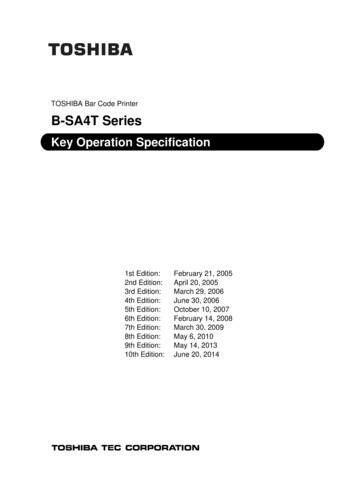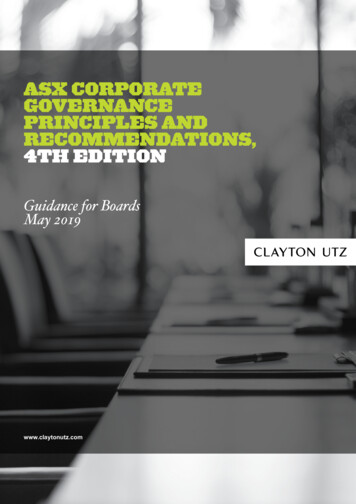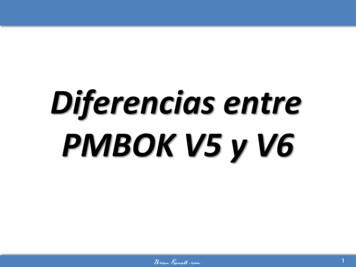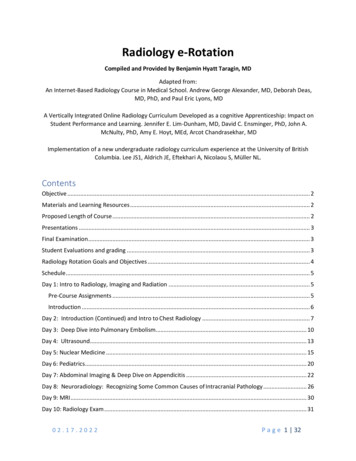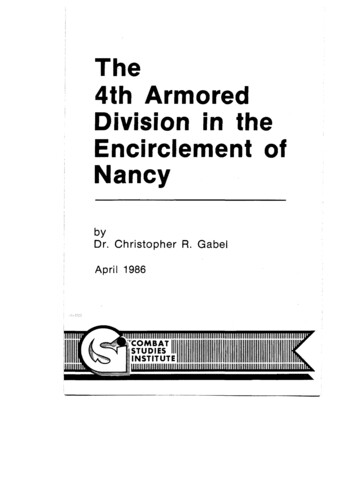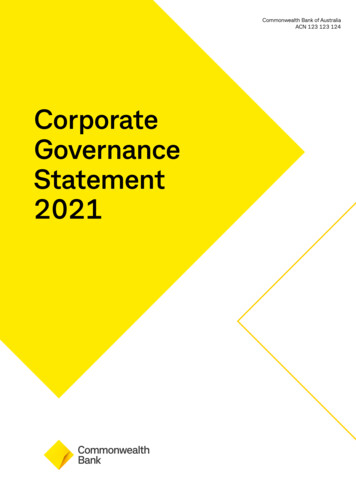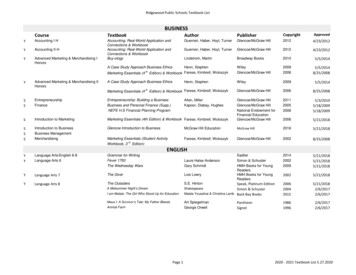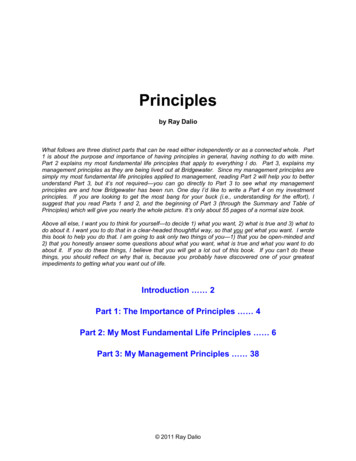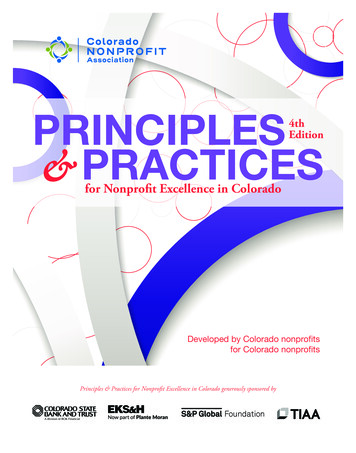
Transcription
PRINCIPLES& PRACTICES4thEditionfor Nonprofit Excellence in ColoradoDeveloped by Colorado nonprofitsfor Colorado nonprofitsPrinciples & Practices for Nonprofit Excellence in Colorado generously sponsored by
Colorado’s over 20,000 nonprofits provide essential services that support, enrich, and inspire communities,enhancing the quality of life all across our great state. Nonprofits also create a substantial economic impact.Laws, regulations, and best practices hold nonprofits to standards of transparency, effectiveness, and efficiency.Principles & Practices for Nonprofit Excellence in Colorado is a powerful and useful tool for all nonprofits as theystrive to reach and maintain these standards. We encourage nonprofit professionals and board members to usethis resource to build their capacity, demonstrate accountability and enhance the public’s trust in the nonprofitcommunity.As elected officials, we lead agencies that have important responsibilities for overseeing charities and nonprofitsin Colorado. We value our ongoing partnership with Colorado Nonprofit Association and the efforts of manyexperts who contributed to the content of this new edition of Principles & Practices for Nonprofit Excellence inColorado.We appreciate the work of thousands of nonprofit professionals, volunteers, and donors to make a differenceevery day in their communities. We are honored to work with these nonprofit organizations.We believe Principles & Practices for Nonprofit Excellence in Colorado will be a valuable guide as we all strive toreach Colorado Nonprofit Association’s vision that Colorado will have the nation’s most effective, vibrant, andinnovative nonprofit community essential to the quality of life in our state.Sincerely,Cynthia CoffmanAttorney GeneralWayne WilliamsSecretary of State
PRINCIPLES& PRACTICES4thEditionfor Nonprofit Excellence in ColoradoTABLE OF CONTENTSIntroduction. 04Advocacy. 05Communications. 10Diversity, Equity, and Inclusion. 15Evaluation. 18Financial Management. 22Fund Development. 29Governance. 35Human Capital Management. 44Information Technology. 50Strategic Planning. 55Additional Resources. 59Contributors. 61Sponsors. 62 2018 Colorado Nonprofit Association. All rights reserved by the copyright holder.CNA PP4thEd 2018-FINAL.indd 39/28/2018 12:46:48 PM
IntroductionPURPOSESLEGAL ACCOUNTABILITYPrinciples & Practices for Nonprofit Excellence in Colorado(P&P) has three intended purposes:All Colorado nonprofits must be aware ofand in compliance with all legal requirementspertaining to nonprofit management, reporting,and governance. Visit the following websites forsummaries of applicable laws, links to helpfulresources, and downloadable forms: The first is to provide individual charitableorganizations striving for excellence witha Colorado-specific tool for evaluatingregulatory compliance, enhancing strategicplanning, and refining operationalevaluation.The second is to support the growth andquality of the nonprofit sector.The third is to increase publicunderstanding of the role and impact of thecharitable nonprofit sector in Colorado.Colorado Nonprofit Association ColoradoNonprofits.orgNote that this guidebook is not meant to beconstrued as legal advice, and is not a substitutefor individualized consultation with an attorney.While legal requirements for nonprofits other than501(c)(3) organizations are not included in thisguidebook, this guide remains a strong tool to helpthose organizations increase good governance,accountability, and transparency.DEFINITIONSA “Principle” is a broad statement that definesa suggested ethical or managerial directionfor a nonprofit organization. A “Practice” is asuggested method to achieve the principles. Inthis guide the terms “charitable organization,”“nonprofit organization,” and “nonprofit” are usedinterchangeably to refer to nonprofit organizationsthat are tax-exempt under § 501(c)(3) of the InternalRevenue Code.GUIDANCE ON USING P&PThe topics are alphabetically ordered. It isencouraged that nonprofit organizations strive toimplement all principles and practices stated inthis edition. However, an organization may findthat certain practices may not apply to it due toorganizational size, life-cycle, and needs.04 Colorado Secretary of StateSOS.state.co.us/Colorado Attorney Generalcoag.govColorado Department of Laborcoworkforce.comColorado Department of Revenuecolorado.gov/revenueInternal Revenue Serviceirs.gov/charitiesIn addition, Colorado nonprofits should takeadvantage of an invaluable resource called A Guidefor Colorado Nonprofit Organizations (2007, ContinuingLegal Education in Colorado, Inc.). More than20 of Colorado’s top corporate attorneys, manyof whom specialize in representing Coloradononprofit organizations, wrote this publication,which is updated regularly.ADDITIONAL RESOURCESP&P recognizes that good organizational practicesare primarily implemented through education andself-regulation. This guide is intended as aneducational resource to help charitable 501(c)(3) organizations to promote good governance,transparency, and accountability.Colorado Nonprofit Association strives to increasethe sustainability of the nonprofit sector byproviding professional development, access to bestpractice knowledge and current trend information.Visit ColoradoNonprofits.org to learn more aboutour resources, including upcoming professionaldevelopment opportunities, online knowledgecenter, and policy updates.Practices with applicable legal citations are noted bythe box.CNA PP4thEd 2018-FINAL.indd 49/28/2018 12:46:48 PM
AdvocacyPRINCIPLESStaff, board members, and volunteers are free to use personal time andresources to support or oppose candidates or engage in other partisanpolitical activities provided they are not representing the organization.(IRS Revenue Ruling 2007-41, 2007-25 I.R.B.)As defined in federal regulations, nonprofits may lobby, i.e.communicating directly or urging the public to communicate, to supportor oppose legislation before a legislative body of voters [26 CFR § 1.501(c)(3) - 1(c)(3)(ii)].Principles & Practices for Nonprofit Excellence in Colorado 4th EditionA nonprofit organization should advocate for the peopleit serves, its organization, and the common interests of thenonprofit sector to operate effectively and advance its mission. Anonprofit should also facilitate community participation in mattersof public interest relevant to its mission through its advocacy strategies.Advocacy means the active support of an idea or a cause to influence publicopinion or public policy. Advocacy comprises a broad array of activitiesincluding civic engagement, public education, and lobbying. A nonprofit’slevel of involvement in advocacy will vary based on the organization’smission, capacity, and strategic direction.Nonprofits can advocate freely provided they follow some important legalrequirements. Under Section 501(c)(3) of the Internal Revenue Code,nonprofits must not engage in partisan political activities including givingmoney to, or supporting or opposing, candidates for elected public office.But nonprofits must follow federal, state, and local laws that define limitson lobbying activities and applicable reporting requirements.05CNA PP4thEd 2018-FINAL.indd 59/28/2018 12:46:48 PM
AdvocacyPRACTICEPLANNING AND ACTIVITIES1. Understanding of Social and PublicPolicy IssuesA nonprofit should continuously maintain anunderstanding of social and public policy issuesand events relevant to the organization’s work.2. Public CommunicationsA nonprofit should ensure that the social andpolitical context of information communicatedpublicly is clear, timely, and accurate. Suchcommunications should be treated aspublic records.Colorado Nonprofit Association ColoradoNonprofits.org3. Relationship BuildingA nonprofit should build relationships withelected officials, community leaders, andother nonprofits in order to strengthen itsability to affect community change andimpact public policy.4. Professional DevelopmentA nonprofit should include advocacy trainingand resources as part of its professionaldevelopment activities for staff andthe organization.5. Advocacy PlanningA nonprofit should have a plan indicating thescope of work, time, and resources devoted toadvocacy. This plan may include both proactiveand responsive strategies.6. Participating in Formation of PublicPoliciesA nonprofit should communicate itsperspective on, or participate in forming oramending, executive, and legislative policiesaddressing issues related to the organization’swork. Where possible, key stakeholders shouldbe involved in these efforts.06CNA PP4thEd 2018-FINAL.indd 6CIVIC ENGAGEMENT AND PUBLICEDUCATION7. Public EducationA nonprofit should provide nonpartisaninformation, training, or other educationalresources to the public on keymission-related issues.8. Stakeholders as AdvocatesA nonprofit should support and encourageboard members, volunteers, and constituentsto act as advocates and ambassadors forthe organization.9. Public DialogueA nonprofit should encourage public dialogue,hold public forums, or provide other methodsfor constituents to express their views onrelevant social or public policy issues.10. Promote Civic EngagementA nonprofit should encourage constituents toparticipate in nonpartisan civic engagementactivities. As defined by the AmericanPsychological Association, civic engagementmeans “individual and collective actionsdesigned to identify and address issues ofpublic concern. Civic engagement can takemany forms, from individual voluntarismto organizational involvement to electoralparticipation. It can include efforts to directlyaddress an issue, work with others in acommunity to solve a problem or interact withthe institutions of representative democracy.”11. Nonpartisan Voter EngagementActivitiesWhere possible, a nonprofit should engage inmission-related activities to educate votersand encourage voter turnout. Nonprofitsmust follow IRS guidance to conduct theseactivities in a lawful, nonpartisan manner.These activities include: providing education on voting and theelections process;9/28/2018 12:46:48 PM
Advocacy conducting get-out-the-vote activities andvoter-registration drives;hosting candidate forums;producing questionnaires or guides toeducate the public about candidates and;publishing voting records ofincumbent members of a legislativebody. (IRS Revenue Rulings 200741, 2007-25 I.R.B. and 78-248,1978-1 C.B. 154)12. Prohibition on Supporting or OpposingCandidates for Elected Public OfficeA nonprofit must not supportor oppose candidates for electedpublic office. This includes avoidingcommunications and activities thatcould be perceived as supportingor opposing candidates or politicalparties [26 USC § 501(c)(3)].13. Prohibition on Expenditures orIn-Kind Contributions for the Benefitof CandidatesA nonprofit must not make anexpenditure or in-kind contributionfor the benefit of an individualcandidate for elected public office, apolitical committee that supports oropposes a candidate, or a politicalparty [26 USC § 501(c)(3)].A staff member, board member,or volunteer for a nonprofitorganization shall not engage inactivities that support or opposecandidates for elected publicoffice, political committees, orpolitical parties during hourswhen the individual is workingor volunteering for, or otherwiserepresenting, the nonprofitorganization (IRS Revenue Ruling2007-41, 2007-25 I.R.B.).Staff, board members, and volunteers mayengage in such activities using their personaltime and resources. A nonprofit organizationshould provide training or guidance to staff,board members, and volunteers as needed toensure organizational time and resources arenot used for partisan political activities.15. Distinction between Personal Opinionsand Organizational PositionsA nonprofit organization should ensurethat board, staff, and volunteers distinguishbetween personal opinions and organizationalpositions on public policy matters,especially in email, online, or social mediacommunications. A nonprofit organization maybe held accountable for statements made bya board member, staff member, or volunteer,particularly political statements.Principles & Practices for Nonprofit Excellence in Colorado 4th EditionLEGAL REQUIREMENTS FORLOBBYING, POLITICAL ACTIVITY,AND WORKING WITH ELECTEDOFFICIALS14. Prohibition on Use of OrganizationalResources for Supporting orOpposing Candidates07CNA PP4thEd 2018-FINAL.indd 79/28/2018 12:46:48 PM
Advocacy16. Insubstantial Part Limit on LobbyingA nonprofit must adhere to limits on lobbying activities under Section 501(c)(3)of the Internal Revenue Code. Lobbying means communicating directly, or urgingthe public to communicate, to support or oppose legislation before a legislative bodyor voters [26 CFR § 1.501(c)(3) - 1(c)(3)(ii)]. These activities to influence legislation,or carry on propaganda, must be an insubstantial part of a nonprofit’s organizationalactivities under 501(c)(3). Unless an organization makes the 501(h) election, the IRSdetermines if a nonprofit’s lobbying activities are substantial based on the facts andcircumstances the nonprofit must report on its annual information return [26 CFR1.162-29(c)(1)].17. 501(h) Expenditure Lobbying LimitColorado Nonprofit Association ColoradoNonprofits.orgA nonprofit should consider filing the IRS Form 5768 to take the 501(h) election.Section 501(h) of the Internal Revenue Code allows a nonprofit’s limit to be measuredbased on lobbying expenditures rather than the insubstantial part limit [26 USC § 501(h)].Under the 501(h) election, a nonprofit must report on both direct and grassroots lobbyingactivities on its annual information return and limit grassroots lobbying expenditures tono more than 25 percent of total lobbying expenditures (26 CFR 56.4911).Direct Lobbying means any attempt to influence any legislation through communicationwith any member or employee of a legislative body, or with any government official oremployee who may participate in the formulation of legislation. Grassroots Lobbyingmeans any attempt to influence any legislation through an attempt to affect the opinionsof the general public or any segment thereof. [(26 CFR 56.4911)]A nonprofit that has taken the 501(h) election must also be aware of exceptions to reportedlobbying activities including:discussion of broad social and economic issues without expressing a view on pendinglegislation or calling for action;nonpartisan analysis or research that may express a view on legislation but has no call toaction, presents facts fully and fairly, and is widely disseminated;technical advice to a legislative body or committee at the invitation of that body orcommittee;“self-defense” communications on legislation affecting an organization’s existence,powers, duties, tax-exempt status, or deductibility of contributions; andmembership communications that reflect a view on legislation of direct interest to theorganization and its members but do not encourage direct or grassroots lobbying (26 CFR56.4911).[For organizations that have not made a 501(h) election, exceptions similar to those fortechnical advice and nonpartisan analysis have been established by case law and IRSRevenue Rulings 64-195, 1964-2 C.B.138 and 70-449, 1970-2 C.B. 111]08CNA PP4thEd 2018-FINAL.indd 89/28/2018 12:46:49 PM
Advocacy18. Prohibition on the Use of FederalFunds for LobbyingNOTESA nonprofit must not use federalfunds to engage in lobbyingactivities. Unless restrictionsapply, other funds may be usedfor lobbying activities (2 CFR §200.450).19. Colorado Reporting of LobbyingActivities20. Compliance with Ethics RulesA nonprofit must comply withfederal, state, and local ethicsrules in working with governmentemployees and public officials. Withrespect to government employeesand officials, this includes rules onproviding gifts, travel, honoraria,or event tickets; and employment offormer elected officials. (ColoradoConstitution Article XXIX; Houseof Representatives Rule XXIII Code of Official Conduct; StandingRules of the Senate, 34 to 43).Principles & Practices for Nonprofit Excellence in Colorado 4th EditionA nonprofit employee whois paid by the organization tolobby must file monthly reportswith the Colorado Secretary ofState on communications to, orcommunications soliciting othersto, influence legislation or publicrulemakings (C.R.S. § 24-6-303).09CNA PP4thEd 2018-FINAL.indd 99/28/2018 12:46:49 PM
CommunicationsPRINCIPLESColorado Nonprofit Association ColoradoNonprofits.orgCommunications strategies advance a nonprofit’smission, inspire its stakeholders, and increase its impact. Anonprofit must be proactive in its communications strategy toaccomplish its goals. Effective communications practices help toensure public trust in the organization and connect the organizationto its stakeholders, inspiring action. Thoughtful planning and internalcommunication are important for positive relationships with employeesand key volunteers. External communications strategies attract and retainstakeholders, raise public awareness, advance key mission-related concepts,and increase funding for the organization.10CNA PP4thEd 2018-FINAL.indd 109/28/2018 12:46:49 PM
CommunicationsPLANNING AND INTERNALCOMMUNICATIONS1. Organizational CommunicationsAll nonprofit communications should adhereto the highest ethical and professionalstandards, as well as any applicable industryspecific standards, and should exhibittransparency, fairness, and honesty. Thesestandards should be clearly stated inwriting and made part of the training andorientation of all employees, board members,and volunteers.2. Written Communications Plan include goals, target audiences, keymessages, strategies, tactics, intendedoutcomes, and the means to evaluate results;include community served (which may bedifferent than target audience);ensure that the organization is makingthe appropriate information availableto the public and communicating in aclear and timely manner with those whorequest information;be shared and regularly reviewed withstaff, board, and key volunteers of theorganization; andbe updated regularly to ensure the plan stayscurrent with the organization’s priorities andcommunication trends such as changes insocial media and technology.3. Communication Procedures/InternalCommunicationsNonprofits should establish clear policiespertaining to communication practicesCNA PP4thEd 2018-FINAL.indd 114. Inclusiveness and CommunicationsInclusive organizations not only have peoplefrom diverse backgrounds involved at all levels,but also are learning-centered and intentionallyincorporate the needs, assets, and perspectivesof all constituents into everything they do.This includes the practice of communications.Nonprofit organizations should providecommunications in languages other thanstandard English, as necessary. As a nonprofitbuilds and implements its communicationspractices, it should ensure that its strategy,messaging, messengers, and materials areinclusive of the voices and experiences ofits constituents.5. Privacy and ConsentNonprofits should establish and implementclear policies regarding confidentialityof certain communications, images, andpersonal information. Sensitive, private,or confidential information should not beshared without express consent. Occasionallypictures of participants, volunteers, or servedcommunity members may need expressconsent to be shared.Principles & Practices for Nonprofit Excellence in Colorado 4th EditionA nonprofit should have a clearly-defined,written communications plan that supportsthe organization’s strategic plan. Thearticulated communications strategies shouldbe integrated into all organizational planning,and should demonstrate accountability toconstituents and the public. The writtencommunications plan should:and procedures including outreach efforts,frequency of communications, graphicstandards, rules around print and electroniccommunications, approval for institutionalfacts and messaging, and expected responsesfor internal or external concerns. Thesepolicies should be included in the writtencommunications plan. Nonprofits shouldestablish thoughtful internal communicationsstrategies – with clear, defined channels thatrespond to the needs and interests of staffmembers and key volunteers – to allow foreffective conflict resolutions, and the creationof a positive, productive organizational culture.6. Crisis Communications PlanA nonprofit should have a written plan forcommunicating with internal audiences, thepublic, and the media at a time of crisis or119/28/2018 12:46:49 PM
Communicationsemergency. A crisis communications plan maybe incorporated into a disaster managementplan or written communications plan.7. Copyright and TrademarksA nonprofit should copyright or trademarkorganizational materials as appropriate.8. EvaluationColorado Nonprofit Association ColoradoNonprofits.orgA nonprofit should take steps to evaluate itscommunications strategies and tactics. Eachstrategy should be designed with a measurableoutcome in mind, and the dollars and timeexpended should be weighed with the successof each strategy. The next step would be toevaluate the outcomes against the proposedmeasurable outcomes.EXTERNAL COMMUNICATIONS9. BrandingA nonprofit should develop and promote a clearunderstanding of its brand. An organization’sbrand is its reputation and personality, and issupported by all of its actions and interactionswith the community. The brand is articulatedthrough consistent communications tacticssuch as key messages, language and tone, logo,and visual identity. Nonprofits should ensureall employees, board members, and volunteershave an understanding of and familiarity withits brand.In accordance with its brand, a nonprofitshould consider implementing a set of graphicstandards that create a visual identity andprovide the rules for using the organization’sfonts, primary colors, accent colors, logos,photography, and other visual assets.10. Marketing12Marketing materials that are distributedto external audiences should be developedand distributed according to a strategic,mission-driven plan. They should representthe organization’s brand and key messages,and reflect its visual identity. ExamplesCNA PP4thEd 2018-FINAL.indd 12of marketing materials include print andelectronic newsletters, websites, social media,annual reports, advertising, collateral orpromotional materials for events, public serviceannouncements, and promotional brochuresand flyers.11. Media RelationsMedia relations is the process of generatingmedia coverage by distributing timely andaccurate press releases; providing print-readycontent to external publications and outlets,including guest commentary and letters to theeditor; and pitching story ideas to journalistswhose coverage aligns with the organization’sissues of concern and areas of expertise. Givenchanges in the media landscape, organizationsshould develop its own “media centers,”wherein press releases, feature stories, issuebriefs, and other information are made availableto the media and public online and by request.12. Digital CommunicationsDigital communications is using digitalformats such as social media and e-marketingto connect with target audiences. It is anessential outlet for a nonprofit’s externalcommunications and an integral part ofa strategic communications plan. Bestpractices for effective digital communicationschange quickly, as outlets, platforms, socialnetworks, and apps change constantly. Digitalcommunications outlets can be used tohighlight news and opportunities, share storiesof impact, solicit volunteers, and promoteevents, among many other possibilities.A nonprofit should understand the tone,functionality, and audience of a given platformin order to use it effectively. A nonprofitshould adopt a digital communications policygoverning the organization’s own social mediachannels and emails, as well as expectationsfor staff, board members, and volunteersregarding any social media activity as it relatesto the organization.In addition, a nonprofit must adhere toanti-spam laws and guidelines. All email9/28/2018 12:46:49 PM
Communicationscommunications should be sent only torecipients who have given either express orimplied permission to be added to email listsand include a means for recipients to removethemselves from the mailing list.13. Public Statements and PositionsA nonprofit should have a written procedurethat stipulates who has the authority tomake public statements on behalf of theorganization, and the procedures fordeveloping the statements. Board members,staff, and volunteers should be trained on theorganization’s statements, positions, policies,and procedures.A nonprofit should encourage all staff, boardmembers, and volunteers to act as ambassadorsfor the organization by providing themwith tools, information, and messaging tobe successful advocates. Nonprofits shouldconsider specific training and regular refreshersfor ambassadors. Ambassadors workingtogether with a consistent, clear message enablea nonprofit to reach more people effectively.15. Distinction between Personal andOrganizational PositionsA nonprofit should educate employees, boardmembers, volunteers, and ambassadors onthe distinction between personal opinion andorganizational positions. This is especiallyimportant when making public statements,using social media, or publishing informationonline or in print. A nonprofit may be heldaccountable for statements made by a board orstaff member.16. Stakeholder EngagementIn order to demonstrate transparency andaccountability, maintain good relationships,and help an organization achieve its mission,nonprofits should engage stakeholders17. Annual ReportsA nonprofit should produce an annual reportthat contains information on its activities,accomplishments, performance, and vision forthe future. Often, the annual report will be themost persistent demonstration of your brand;ensure that the elements of your visual identityare well represented. Organizations may chooseto only offer its report in an electronic format,which is more cost effective and allows moreoptions, including embedded content (e.g.videos, links, etc.). However, a more succinctprinted version may be a beneficial takeawayduring trainings and events, and offers aphysical representation of the organization. Toensure direct and effective communication,organizations should decide on the audienceand goals of the report.Content should include: overall financial information, includingincome and expense statement, balancesheet, and functional expense allocation;Principles & Practices for Nonprofit Excellence in Colorado 4th Edition14. Ambassadorsthrough clear, easily accessible, and up-to-dateinformation. Opportunities to solicit feedbackshould be targeted to key audiences identifiedin the communications plan. For example,surveys, and other webforms, communitymeetings, and other methods should be easilyaccessible by outside audiences through theorganization’s outlets of communication.Staff contact information will assist in theseinteractions. In the case of negative feedback,organizations should have a written grievancepolicy in order to promptly and respectfullyrespond to grievances or complaints fromstakeholders. These practices help fosterdialogue and mitigate potential negative impactto the organization and its stakeholders.an explanation of the organization’s mission,activities, and impact;an explanation of the organization’s outreachefforts and ways in which constituents mayaccess the program(s); anda list of board members, staff, volunteers,and, when appropriate, contributors.13
CommunicationsContent to Consider:to bring your mission to life, include stories,photography, infographics, etc.to support fundraising, include testimonialsfrom current donors NOTES18. Legal Requirements for Public Accessto InformationColorado Nonprofit Association ColoradoNonprofits.orgA nonprofit should make information aboutits operations, including its governance,finances, programs, and activities, widelyavailable to the community. Full disclosureof executive compensation, includingcompensation received from related entitiesof the organization, must be disclosed on theorganization’s IRS form 990. A nonprofitshould consult legal and financial professionalsto determine the requirements for publicdisclosure. At a minimum, a nonprofit (unlessspecifically exempt) must make certain dataavailable to the public including:tax return (usually an IRS annualForm 990, 990-EZ, 990-N or 990- PF) for the most recent three years(IRC § 6104);if the organization has unrelatedbusiness income, annual tax return(usually an IRS Form 990-T) for themost recent three years; andIRS Form 1023, Application forRecognition of Tax-Exempt Status,including any papers submittedin support of the Application andany letter or other document issuedby the IRS with respect to theApplication (IRC § 6104; 990).14CNA PP4thEd 2018-FINAL.indd 149/28/2018 12:46:49 PM
DIVERSITY, EQUITY, ANDINCLUSIONPRINCIPLESThe
Principles Practices for Nonprofit Ecellence in Colorado 4th Edition ADvoCACY PRInCIPLES A nonprofit organization should advocate for the people it serves, its organization, and the common interests of the nonprofit sector to operate effectively and advance its mission. A nonprofit

